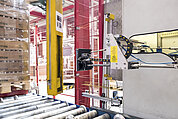Barcode labels
Barcode labels and the GS1 standards
Many of the barcode labels created nowadays conform to one of the standards developed by the GS1.
The GS1 is a non-for-profit organization that develops business standards in the area of communication. Several barcodes have been established from standards developed by the GS1, including the UPC-A code, the EAN-8 code or the GS1 Datamatrix code. Some of the most important standards developed by the GS1 include:
- The Global Location Number (GLN). This number can be used to identify any legal, physical and functional location of a supplier. The GLN has a standardised format. Its structure is such that any location worldwide can be uniquely and distinctly identified.
- The European Article Number (EAN) code. EAN codes are used for cross-organisational identification of articles and products of any origin (consumer and trading units). They provide information for the purposes of identification only (they are not relevant to article classification or description). Today, some 250,000 businesses employ the EAN code that is maintained by an international network of 59 official code issuers representing 65 countries. The EAN code and the corresponding barcode system together with the UPC codes used in the USA are now in use throughout the world.
- The Serial Shipping Container Code (SSCC). The SSCC was developed in order to provide for the identification of individual transport containers. It facilitates the supply, distribution and receipt of items packed in non-standardised containers. As a pure identification code, the SSCC, like the EAN code, provides certain information. In contrast with the EAN code that is assigned to a specific item, the SSCC provides no information on the corresponding article. The 18-character SSCC is at the core of the GS1 system.
- The GS1-128 barcode. This barcode allows organizations to encode information containing up to 40 elements in a single barcode. Hence, a barcode can provide information relevant to identification (e.g. EAN, SSCC), product tracking (e.g. SSCC, batch number), dates (e.g. date of production, expiry date), units of scale (e.g. weight in kilograms), reference numbers (e.g. order number of the recipient), company IDs (e.g. company ID of the recipient) and internal uses.
Benefits of GS1-conforming barcode labels
Using barcode labels that conform to the GS1 standards has many advantages, including the following:
- They allow continuous tracking of consignments from sender to recipient.
- They facilitate the work of shippers transporting consolidated cargoes.
- GS1-conforming barcode labels provide more information than other barcodes.
- Scanning errors are eliminated.
- They allow checks that consignments are complete and prevent inappropriate surplus.
- Additional control characters can be appended to the barcode (e.g. order number, expiry date, batch size).
Stipulations that apply to GS1-conforming labels
GS1-conforming labels must respect certain stipulations. In particular, length, including blank areas, may not exceed 165 mm.
In addition to the data designator, there may be no more than 48 user data characters. In the case of the GS1-128 barcode, there may be no more than 35 symbol characters, including all extension symbols and the check digit character. There is otherwise the risk that the information multiplication factor may become too large in the case of cross-organisational distribution.
Barcodes labels and product recalls
It is particularly important to be able to track products all the way from supplier to outlet in case it becomes necessary to recall them. In the past, there have been repeated cases of recall actions in crisis situations in which it was apparent that more targeted cross-company tracking and return procedures should have been implemented.
Barcode labels are used for recall actions in order to find defective products quickly so that they can be removed from circulation, thus preventing their use and limiting any possible damage that may be caused. This allows manufacturers to manage product recalls more efficiently. In particular, barcode labels offer the following advantages when it comes to product recalls:
- Manufacturers are able to access information on the specific location of a product along the supply chain to point of sale.
- They are able to selectively remove the product or range in question wherever it might be at a particular time.
- Barcode labels provide for the protection of consumers by ensuring they are not in possession of a defective product.
- Barcode labels reduce any loss of reputation due to product defectiveness.
Applications
Learn more about our marking solutions practically implemented at the customer's site
Packages ready to ship in 5 minutes
Fast labeling - packages ready to ship in 5 minutes. How label printers and applicators are essential to automate logistics at shoe retailer Görtz...
GS1-compliant pallet labelling at ALPLA
GS1-compliant pallet labelling at ALPLA in Berlin - How Weber Marking Systems supports sustainability efforts in packaging production...



